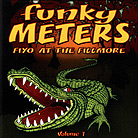June 2003
The band reformed, with drummer David Russell Batiste, Jr. replacing Modeliste, after a jam session in 1989. When guitarist Brian Stoltz joined them in 1994, they christened themselves the Funky Meters. More than the name changed. This version of the band leans more towards rock and has less of the spaciousness that made the original band so noteworthy. The Meters stood out because of what they chose to leave out. They created exquisite tension by playing precisely the right note in the right place -- not always the place you expected it to be -- and not one note more. On their new live album, Fiyo at the Fillmore, the Funky Meters generate more sound than the original band, but they still know how to throw some heat. A lot of New Orleans keyboard history flows through Art Neville’s hands and he lays down the groove for this band to follow. As the primary vocalist, Neville is also, in essence, the face of the Funky Meters. George Porter calls so little attention to himself that it takes a while to hear how much snap his bass lines have. Batiste plays with a little more force than Modeliste, but he has a firm grasp on many of the intricate rhythms that are a key ingredient in the band’s sound. In the end, though, it’s Brian Stoltz who dominates Fiyo at the Fillmore. He returns the long, blues-based electric guitar solo to a place of honor. You can easily point to the guitarists he’s learned from -- Duane Allman and Jimi Hendrix especially -- but his solos are blistering and varied, and he rarely repeats himself in the ample solo time given him. More important, he keeps things exciting and doesn’t noodle. Stoltz plays a lot in this long disc (76:24, including a 4:41 studio track that closes it), but he doesn’t wear you down. If Stoltz has a weakness, it’s that he relies too heavily on the delay and chorus pedals when he plays rhythm guitar. It clutters the sound and he’s too strong a player to rely on those effects. It also makes the band’s sound lean more in a rock direction. I’m sure that’s a conscious decision on their part and it probably helps them pull in the jam-band crowd. But a comparison of "Cissy Strut" or "People Say" here with the original versions leaves me longing in some ways to hear the originals. They’re funkier. There’s still enough grease here to get you up and moving, but much of what gives the band the right to its name -- the subtlety of Porter’s and Batiste’s playing -- gets lost in a wall of guitar sound. Art Neville keeps things loose and flowing here, but he occasionally relies too heavily on some electronic keyboards, especially an Ensoniq, that he breathes as much life into as anyone can. As soon as he plays a riff on the Hammond organ on "Keep on Marching" you know that some instruments are inherently soulful and some are not. If Art Neville can’t loosen up an Ensoniq, no one can. Why not a Fender Rhodes, which has some of the same tonal characteristics, but has a funkier sound? Fiyo at the Fillmore has a lot of old-rock-hall ambiance, and it’s a very honest live record. There are a few sour notes, missed beats, and flubbed chord changes and, to their credit, the band didn’t overdub them. The recording is a little distant and boxed in, but the performance is energetic, and the band sounds like it’s enjoying itself. I like this disc if I think of it as a jam-band disc rather than as a blues or soul disc. Any reservations I have are based solely on my fondness for the original band. If I put any assumptions I have about the Meters aside, there’s a lot about the Funky Meters to dance to and enjoy. GO BACK TO: |
 Funky Meters - Fiyo at the Fillmore,
Volume 1
Funky Meters - Fiyo at the Fillmore,
Volume 1 The New Orleans band the
Meters made ten albums between 1967 and 1979 (nicely overviewed in the Rhino Records
collection Funkify Your Life) before breaking up and going their separate musical
ways. Art and Cyril Neville joined their two brothers, Aaron and Charles, to form the
Neville Brothers, while bassist George Porter, Jr., drummer Joseph "Zigaboo"
Modeliste, and guitarist Leo Nocentelli went on to record or tour with an honor roll of
musicians that would almost literally fill this page. The Meters themselves played on
recordings by Patti Labelle, Paul McCartney, and Dr. John, among others, and on every
outing their understated funk brought a hint of taste and class to the proceedings.
The New Orleans band the
Meters made ten albums between 1967 and 1979 (nicely overviewed in the Rhino Records
collection Funkify Your Life) before breaking up and going their separate musical
ways. Art and Cyril Neville joined their two brothers, Aaron and Charles, to form the
Neville Brothers, while bassist George Porter, Jr., drummer Joseph "Zigaboo"
Modeliste, and guitarist Leo Nocentelli went on to record or tour with an honor roll of
musicians that would almost literally fill this page. The Meters themselves played on
recordings by Patti Labelle, Paul McCartney, and Dr. John, among others, and on every
outing their understated funk brought a hint of taste and class to the proceedings.